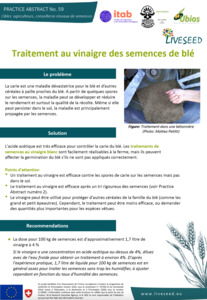{Tool} Treating wheat seed with vinegar against common bunt (Liveseed Practice abstract). Creator(s): Borgen, Anders; Klaedtke, Stephanie; Boffin, Laurane and Bouchet, Jean-Pierre. Issuing Organisation(s): Agrologica, ITAB - Institute for Organic Agriculture and Food. Liveseed Practice Abstract, no. 59. (2021)
|
PDF
- Published Version
- English
(Treating wheat seed with vinegar against common bunt (Liveseed Practice abstract))
519kB | |
|
PDF
- Published Version
- French/Francais
556kB | |
![[thumbnail of PA59.png]](/39853/4.hassmallThumbnailVersion/PA59.png)  Preview |
Image (PNG)
- Cover Image
- French/Francais
1MB |
Document available online at: https://www.liveseed.eu/wp-content/uploads/2021/04/PA59_Treating-wheat-seed-with-vinegar-against-common-bunt.pdf
Summary in the original language of the document
Practical recommendations
• For 100 kg seed, approx. 1,7 l of vinegar (4%) (If the concentration is more then 4%, dilute with cold water to reach 4%. According to practical experience, 1,7 l of liquid for 100 kg of seed is usually enough to treat all seeds without wetting them too much, but you may need to adjust according to seed humidity.)
• On-farm, you can use a cement drum to treat seed batches. For small seed quantities (e.g. in collections), you can simply use a hand-sprayer for treating, while shaking the seeds in a small container.
• Avoid using high concentrations: beyond 5% acetic acid, germination rates are reduced in some experiments.
• Dry quickly and thoroughly the seeds after treating to preserve seed quality.
• If the treated seed is actively dried after treatment (e.g. by a hot airstream), let the vinegar work on the seed for approximately a minute before drying.
• Make sure that the entire seed surface is covered! It is crucial that the application is as uniform as possible, as fast as possible, to avoid the acetic acid from evaporating and the seed from imbibing too much liquid.
| EPrint Type: | Practice tool |
|---|---|
| What problem does the tool address?: | Common bunt is a devastating seed borne disease in wheat and related cereals. Starting from just a few spores in a seed batch, the disease can develop in the crop reducing grain yield and especially quality. |
| What solution does the tool offer?: | Vinegar treatment Acetic acid is very effective to control common bunt in wheat. Seed treatments with white vinegar can easily be applied on-farm, but germination can be harmed if it is not applied properly. Caution: A vinegar treatment will protect seeds from bunt spores on the seed, but not in the soil. It is efficient after proper seed cleaning. Can be used to protect related (hulled) cereals (such as spelt and emmer) from bunt, but might be less effective, or greater quantities are needed. |
| Country: | Denmark, France |
| Type of Practice Tool: | Practice abstracts |
| Keywords: | seed quality, seed treatment |
| Agrovoc keywords: | Language Value URI English seed quality http://aims.fao.org/aos/agrovoc/c_14172 English seed treatment http://aims.fao.org/aos/agrovoc/c_6940 |
| Subjects: | Crop husbandry Crop husbandry > Crop health, quality, protection |
| Research affiliation: | Denmark > Agrologica European Union > Horizon 2020 > Liveseed European Union > Horizon 2020 > Liveseed > Liveseed tools France > ITAB - Institut Technique en Agriculture Biologique France > Other organizations France European Union > Organic Farm Knowledge |
| Horizon Europe or H2020 Grant Agreement Number: | 727230 |
| Related Links: | https://organic-farmknowledge.org/tool/39853, https://organic-farmknowledge.org/tool/37866 |
| Project ID: | ofk |
| Deposited By: | Ortolani, Dr. Livia |
| ID Code: | 39853 |
| Deposited On: | 19 May 2021 08:47 |
| Last Modified: | 14 Aug 2024 08:46 |
| Document Language: | English, French/Francais |
| Status: | Published |
Repository Staff Only: item control page


